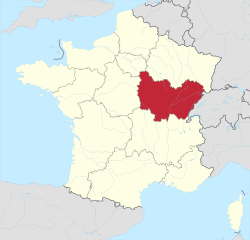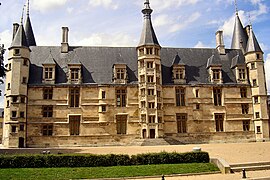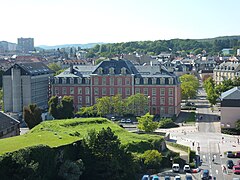Bourgogne-Franche-Comté
Bourgogne-Franche-Comté
Borgogne-Franche-Comtât (Arpitan) | |
|---|---|
Clockwise from top: the Cathedral of Saint John in Besançon; the Théâtre de Lons-le-Saunier; the Loire Bridge and the Cathedral in Nevers; and view of Dijon | |
|
| |
 | |
| Country | |
| Capital | Besançon |
| Largest city | Dijon |
| Departments | |
| Government | |
| • President of the Regional Council | Marie-Guite Dufay (PS) |
| • Prefect | Bernard Schmeltz |
| Area | |
| • Total | 47,783 km2 (18,449 sq mi) |
| • Rank | 6th |
| Population (Jan. 2019)[1] | |
| • Total | 2,805,580 |
| • Density | 59/km2 (150/sq mi) |
| Time zone | UTC+01:00 (CET) |
| • Summer (DST) | UTC+02:00 (CEST) |
| ISO 3166 code | FR-BFC |
| GDP | Ranked 11 of 18 |
| Total | 76.6 € billion (EUR€ bn) |
| Per capita | 24,200 € (EUR€) |
| Website | www |
Bourgogne-Franche-Comté (meaning Burgundy–Free County) is one of the administrative regions of France. It is in eastern France and was formed in 2016 from two old regions: Bourgogne and Franche-Comté.
Geography
[change | change source]
The Bourgogne-Franche-Comté region is the sixth largest region of France with an area of 47,783.3 km2 (18,449 sq mi).[2] It is in northeastern France and borders to the north with the Grand Est region, to the west with Île-de-France and Centre-Val de Loire regions, to the south with the Auvergne-Rhône-Alpes region, and to the east with Switzerland (the cantons of Vaud, Neuchâtel and Jura).
The distances from Besançon, the capital of the region, to other cities are:
- Paris, the national capital, 410 km (255 mi);
- Bordeaux, 729 km (453 mi);
- Toulouse, 762 km (473 mi);
- Marseille, 538 km (334 mi);
- Lyon, 227 km (141 mi);
- Montpellier, 523 km (325 mi);
- Nice, 694 km (431 mi).
Rivers
[change | change source]The main rivers in the region are the Saône and its tributary the Doubs. The Loire river flows through the southwest of the region, at Nevers. The Seine river starts in the Côte-d'Or department.
Mountains
[change | change source]There are three main mountain ranges in the region:
- The Vosges Mountains are in the northeast of the region and its highest point in Bourgogne-Franche-Comté is Ballon de Servance, 1,216 m (3,990 ft) high.
- The Jura Mountains are along the eastern limits; here is Crêt Pela, the highest point in Bourgogne-Franche-Comté with 1,495 m (4,905 ft).
- The Morvan mountains are in the centre of the western part; it highest point is Haut-Folin, 901 m (2,956 ft) high.
The Crêt Pela (46°24′50″N 6°1′19″E / 46.41389°N 6.02194°E), at 1,495 m (4,905 ft), is the highest mountain of the Bourgogne-Franche-Comté region.[3] It is in the Jura mountain range.
The highest point of the different departments in the Bourgogne-Franche-Comté region are:[4]
| Department | Mountain | Elevation |
|---|---|---|
| Côte-d'Or | Mont de Gien | 721 m (2,365 ft) |
| Doubs | Mont d'Or | 1,461 m (4,793 ft) |
| Jura | Crêt Pela | 1,495 m (4,905 ft) |
| Nièvre | Mont Préneley | 855 m (2,805 ft) |
| Haute-Saône | Ballon de Servance | 1,216 m (3,990 ft) |
| Saône-et-Loire | Haut-Folin | 901 m (2,956 ft) |
| Yonne | Bois de la Pérouse | 607 m (1,991 ft) |
| Territoire de Belfort | Ballon d'Alsace | 1,247 m (4,091 ft) |
Departments
[change | change source]The Bourgogne-Franche-Comté region is formed by 8 departments:
| ISO 3166-2 |
Shield | Department | Prefecture | Arr. | Cant. | Comm. | Population (2014)[5] |
Area (km²) |
Density (Inh./km²) |
|---|---|---|---|---|---|---|---|---|---|
| FR-21 | Côte-d'Or | Dijon | 3 | 23 | 704 | 531,380 | 8,763.2 | 60.6 | |
| FR-25 | Doubs | Besançon | 3 | 19 | 578 | 534,710 | 5,232.6 | 102.2 | |
| FR-39 | Jura | Lons-le-Saunier | 3 | 17 | 509 | 260,681 | 4,999.2 | 52.1 | |
| FR-58 | Nièvre | Nevers | 4 | 17 | 309 | 213,569 | 6,816.7 | 31.3 | |
| FR-70 | Haute-Saône | Vesoul | 2 | 17 | 542 | 238,347 | 5,360.1 | 44.5 | |
| FR-71 | Saône-et-Loire | Mâcon | 5 | 29 | 567 | 555,788 | 8,574.7 | 64.8 | |
| FR-89 | Yonne | Auxerre | 3 | 21 | 428 | 341,814 | 7,427.4 | 46.0 | |
| FR-90 | Territoire de Belfort | Belfort | 1 | 9 | 102 | 144,334 | 609.4 | 236.8 | |
| Total of the Region | 24 | 152 | 3,739 | 2,820,623 | 47,783.3 | 59.0 | |||
Arr. = Arrondissements Cant. = Cantons Comm. = Communes
Demographics
[change | change source]The Bourgogne-Franche-Comté region had, in 2014, a population of 2,820,623,[6] for a population density of 59.0 inhabitants/km2. The department with more people living in it is Saône-et-Loire with 555,788 inhabitants.
After the Territoire de Belfort, the smallest department in the region, Doubs is the department with highest population density (102 inhabitants/km2). The density in the other departments is lower.
Gallery
[change | change source]Related pages
[change | change source]References
[change | change source]- ↑ "Téléchargement du fichier d'ensemble des populations légales en 2019". The National Institute of Statistics and Economic Studies. 28 December 2020.
- ↑ "Région de Bourgogne-Franche-Comté (27)". Comparateur de territoire (in French). Institut national de la statistique et des études économiques - INSEE. Retrieved 23 June 2017.
- ↑ "Crêt Pela, France/Spain". Peakbagger.com. Retrieved 23 June 2017.
- ↑ "France Department High Points". Peakbagger.com. Retrieved 23 June 2017.
- ↑ "Populations légales 2014 des départements et des collectivités d'outre-mer" (in French). Institut national de la statistique et des études économiques - INSEE. Retrieved 20 March 2017.
- ↑ "Populations légales 2014: Recensement de la population - Population des régions" (in French). Institut national de la statistique et des études économiques - INSEE. Retrieved 23 June 2017.
Other websites
[change | change source]- Regional Council website (in French)
- Prefecture of the region












